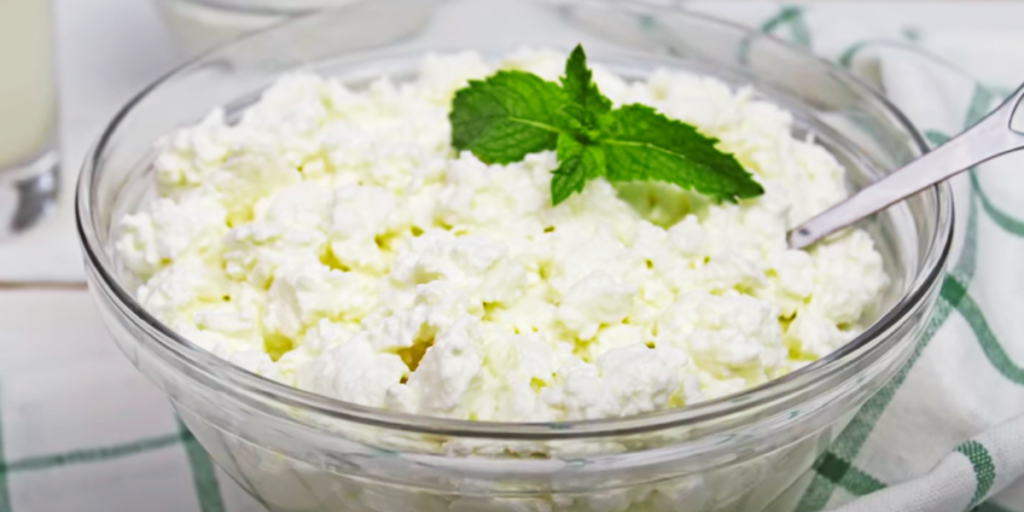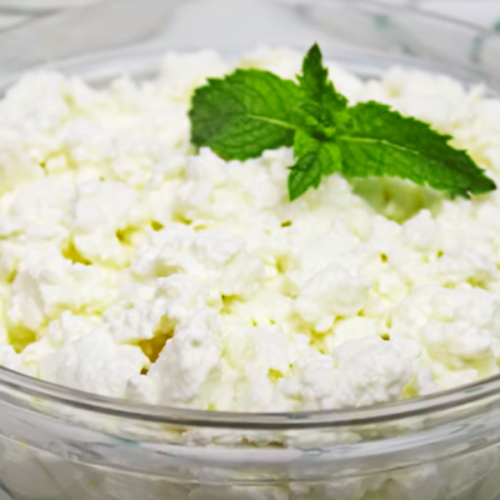Introduction
The cottage cheese recipe, with its creamy texture and mild flavor, has been a staple in kitchens for centuries. It’s a versatile dairy product that can be enjoyed on its own, as a topping, or as an ingredient in various dishes. Making cottage cheese at home not only ensures its freshness but also allows you to customize its flavor to your liking.
What is cottage cheese?
Cottage cheese is fresh cheese prepared from cow’s milk curds. It has a mild flavor and a creamy texture, making it a popular choice for many dishes.
History and Origin
Cottage cheese has been a part of culinary traditions for centuries. Its origins can be traced back to Eastern Europe and the Middle East, where it was commonly made in small cottages, hence the name “cottage cheese.”
Equipment You’ll Need
Gather the following equipment before you begin:-
- Saucepan
- Thermometer
- Cheesecloth
- Colander
Ingredients You’ll Need
- 1 Litre full-fat Milk
- 1 to 2 tbsp Acidic agent (like lemon juice or vinegar)
- Salt (optional)

Step-by-Step Instructions
Step1. Heating the Milk:
- Pour the milk into a saucepan and heat it over medium heat until it reaches around 180°F (82°C). Stir occasionally to prevent scorching.
Step2. Adding the Acidic Agent:
- Once the milk reaches the desired temperature, add the acidic agent (lemon juice or vinegar) gradually while stirring gently. You’ll start to see curds forming as the milk separates from the whey.
Step3. Draining the Whey:
- Line a colander with cheesecloth and position it over a big bowl. Pour the curdled milk mixture into the cheesecloth-lined colander to separate the curds from the whey. Allow it to drain for around 5–10 minutes.
Step4. Pressing the Cheese:
- Gather the edges of the cheesecloth and twist them together to form a pouch around the curds. Apply gentle pressure to squeeze out any excess whey. You can also use a weight to press the cheese into a firm block.

Homemade Cottage Cheese Recipe: Satisfyingly Savory
Equipment
- Saucepan
- Thermometer
- Cheesecloth
- Colander
Ingredients
- 1 Litre full-fat Milk
- 1 to 2 tbsp Acidic agent (like lemon juice or vinegar)
- Salt (optional)
Instructions
Step1. Heating the Milk:
- Pour the milk into a saucepan and heat it over medium heat until it reaches around 180°F (82°C). Stir occasionally to prevent scorching.
Step2. Adding the Acidic Agent:
- Once the milk reaches the desired temperature, add the acidic agent (lemon juice or vinegar) gradually while stirring gently. You’ll start to see curds forming as the milk separates from the whey.
Step3. Draining the Whey:
- Line a colander with cheesecloth and position it over a big bowl. Pour the curdled milk mixture into the cheesecloth-lined colander to separate the curds from the whey. Allow it to drain for around 5–10 minutes.
Step4. Pressing the Cheese:
- Gather the edges of the cheesecloth and twist them together to form a pouch around the curds. Apply gentle pressure to squeeze out any excess whey.You can also use a weight to press the cheese into a firm block.
Notes
Total Nutrition Information
The approximate nutrition information for a typical serving (100 grams) of cottage cheese:-- Calories: 98 kcal
- Protein: 11 grams
- Fat: 4 grams
- Saturated Fat: 2 grams
- Carbohydrates: 3.4 grams
- Sugars: 3.4 grams
- Fiber: 0 grams
- Calcium: 83 mg
- Sodium: 364 mg
- Potassium: 83 mg
Serving Suggestions
Cottage cheese recipe can be enjoyed in various ways:-
- Plain with fruit or honey
- Mixed into salads or pasta dishes
- Spread on toast or crackers
- Blended into smoothies
Tips for Making the Perfect Cottage Cheese Recipe at Home
- Use fresh milk for the best results.
- Be patient when letting the curds separate from the whey.
- Experiment with different types of vinegar or lemon juice for varied flavors.
Variations and Additions
Once you have mastered the basic cottage cheese recipe, you can experiment with different flavorings, herbs, and spices to customize it to your taste. Try adding chopped herbs like dill or chives, or spices like garlic powder or paprika for a unique twist.
Related recipe
Flavoring and Seasoning Options
Cottage cheese recipe can be customized with various flavors and seasonings to suit your taste preferences.
Sweet Variations
- Mix in honey, fresh fruit, or cinnamon for a delicious breakfast or dessert option.
Savory Flavors
- Add herbs, spices, or chopped vegetables to create savory cottage cheese dishes like salads or dips.
Health Benefits of Cottage Cheese Recipe
Cottage cheese is not only delicious but also nutritious. It is rich in protein, making it an excellent choice for vegetarians and anyone looking to increase their protein intake. It is also high in calcium, which is essential for strong bones and teeth, and low in fat, making it a healthier alternative to other dairy products like cream cheese or sour cream.
Common Mistakes to Avoid
Overheating the milk can cause it to scorch and affect the taste of the cottage cheese.
Adding too much lemon juice or vinegar can make the cheese overly sour.
Skipping the draining process can result in a watery cottage cheese.
Popular Variations and Types
Cottage cheese comes in various forms to suit different preferences and dietary needs.
Creamed Cottage Cheese
- Creamed cottage cheese is blended until smooth, resulting in a creamy texture perfect for spreading on toast or crackers.
Dry Cottage Cheese
- Dry cottage cheese has a firmer texture and is ideal for crumbling over salads or incorporating into recipes.
Low-Fat Cottage Cheese
- For those seeking a lighter option, low-fat cottage cheese offers the same flavor and texture with reduced fat content.
Storage Tips and Shelf Life
Store cottage cheese in a container that’s airtight in the refrigerator. It is best consumed within 5–7 days of preparation.
Tips for Success
- Use whole milk for a creamier texture and richer flavor.
- Adjust the amount of acidic agent to control the level of tanginess in your cheese.
Recipes Using Cottage Cheese
- Cottage cheese pancakes
- Cottage cheese salad
- Cottage cheese smoothie
- Cottage cheese dip
Total Nutrition Information
The approximate nutrition information for a typical serving (100 grams) of cottage cheese:-
- Calories: 98 kcal
- Protein: 11 grams
- Fat: 4 grams
- Saturated Fat: 2 grams
- Carbohydrates: 3.4 grams
- Sugars: 3.4 grams
- Fiber: 0 grams
- Calcium: 83 mg
- Sodium: 364 mg
- Potassium: 83 mg
FAQs About Cottage Cheese Recipe
Q1. Is cottage cheese suitable for lactose-intolerant individuals?
- While cottage cheese contains lactose, some lactose-intolerant individuals may tolerate it better than other dairy products due to its lower lactose content. It’s best to consult with a healthcare professional to determine individual tolerance levels.
Q2. Can cottage cheese be frozen?
- Yes, cottage cheese can be frozen, but its texture may change slightly upon thawing. It’s recommended to consume it within a few weeks for the best quality.
Q3. Is cottage cheese a good source of probiotics?
- While cottage cheese is made from fermented milk, most commercial varieties are pasteurized, which kills off any beneficial bacteria. For probiotic benefits, look for brands that specifically state they contain live and active cultures.
Q4. What can I substitute for cottage cheese in recipes?
- Greek yogurt, ricotta cheese, or tofu can be used as substitutes for cottage cheese in recipes, depending on the desired texture and flavor.
Q5. Is cottage cheese safe to eat during pregnancy?
- Yes, cottage cheese is safe to eat during pregnancy as long as it’s made from pasteurized milk. However, it’s essential to consume it within its expiration date and store it properly to prevent foodborne illnesses.
Conclusion
Making cottage cheese recipe at home is a rewarding and straightforward process that allows you to enjoy this versatile dairy product at its freshest. With just a few simple ingredients and steps, you can create creamy, flavorful cottage cheese to elevate your dishes and snacks.

Hi There! I’m Pintu Kumar, the author of this site and Welcome to SuperTestyRecipe.com I love to cook and try various recipes and in free like I use to write posts over here!
Thanks for Attention ♥

1 thought on “Homemade Cottage Cheese Recipe: Satisfyingly Savory”